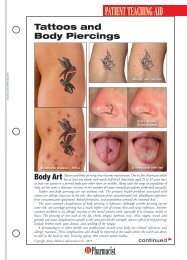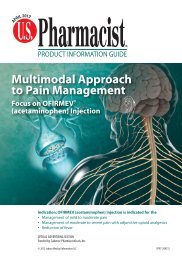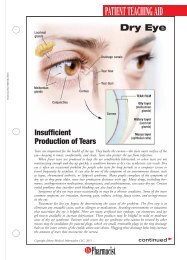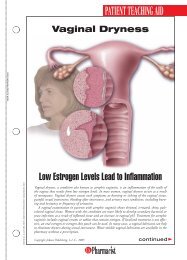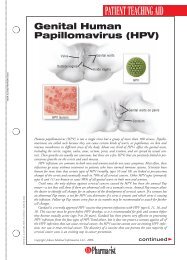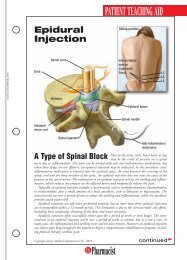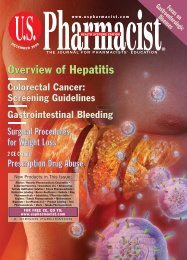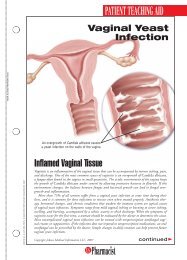View PDF Edition - U.S. Pharmacist
View PDF Edition - U.S. Pharmacist
View PDF Edition - U.S. Pharmacist
You also want an ePaper? Increase the reach of your titles
YUMPU automatically turns print PDFs into web optimized ePapers that Google loves.
USE IN SPECIFIC POPULATIONSPregnancyPregnancy Category C: There are no adequate and well-controlled studies inpregnant women. ULORIC should be used during pregnancy only if the potentialbenefit justifies the potential risk to the fetus.Febuxostat was not teratogenic in rats and rabbits at oral doses up to 48 mg per kg(40 and 51 times the human plasma exposure at 80 mg per day for equal bodysurface area, respectively) during organogenesis. However, increased neonatalmortality and a reduction in the neonatal body weight gain were observed whenpregnant rats were treated with oral doses up to 48 mg per kg (40 times thehuman plasma exposure at 80 mg per day) during organogenesis and throughlactation period.Nursing MothersFebuxostat is excreted in the milk of rats. It is not known whether this drug isexcreted in human milk. Because many drugs are excreted in human milk, cautionshould be exercised when ULORIC is administered to a nursing woman.Pediatric UseSafety and effectiveness in pediatric patients under 18 years of age have notbeen established.Geriatric UseNo dose adjustment is necessary in elderly patients. Of the total number of subjectsin clinical studies of ULORIC, 16 percent were 65 and over, while 4 percent were75 and over. Comparing subjects in different age groups, no clinically significantdifferences in safety or effectiveness were observed but greater sensitivity ofsome older individuals cannot be ruled out. The C max and AUC 24 of febuxostatfollowing multiple oral doses of ULORIC in geriatric subjects ( 65 years) weresimilar to those in younger subjects (18-40 years).Renal ImpairmentNo dose adjustment is necessary in patients with mild or moderate renalimpairment (Cl cr 30-89 mL per min). The recommended starting dose of ULORICis 40 mg once daily. For patients who do not achieve a sUA less than 6 mg perdL after 2 weeks with 40 mg, ULORIC 80 mg is recommended.There are insufficient data in patients with severe renal impairment (Cl cr lessthan 30 mL per min); therefore, caution should be exercised in these patients.Hepatic ImpairmentNo dose adjustment is necessary in patients with mild or moderate hepaticimpairment (Child-Pugh Class A or B). No studies have been conducted inpatients with severe hepatic impairment (Child-Pugh Class C); therefore, cautionshould be exercised in these patients.Secondary HyperuricemiaNo studies have been conducted in patients with secondary hyperuricemia (includingorgan transplant recipients); ULORIC is not recommended for use in patients whomthe rate of urate formation is greatly increased (e.g., malignant disease and itstreatment, Lesch-Nyhan syndrome). The concentration of xanthine in urinecould, in rare cases, rise sufficiently to allow deposition in the urinary tract.OVERDOSAGEULORIC was studied in healthy subjects in doses up to 300 mg daily for sevendays without evidence of dose-limiting toxicities. No overdose of ULORIC wasreported in clinical studies. Patients should be managed by symptomatic andsupportive care should there be an overdose.CLINICAL PHARMACOLOGYPharmacodynamicsEffect on Uric Acid and Xanthine Concentrations: In healthy subjects, ULORICresulted in a dose dependent decrease in 24-hour mean serum uric acidconcentrations, and an increase in 24-hour mean serum xanthine concentrations.In addition, there was a decrease in the total daily urinary uric acid excretion.Also, there was an increase in total daily urinary xanthine excretion. Percentreduction in 24-hour mean serum uric acid concentrations was between 40% to55% at the exposure levels of 40 mg and 80 mg daily doses.Effect on Cardiac Repolarization: The effect of ULORIC on cardiac repolarizationas assessed by the QTc interval was evaluated in normal healthy subjects and inpatients with gout. ULORIC in doses up to 300 mg daily, at steady state, did notdemonstrate an effect on the QTc interval.Special PopulationsRenal Impairment: Following multiple 80 mg doses of ULORIC in healthy subjectswith mild (Cl cr 50-80 mL per min), moderate (Cl cr 30-49 mL per min) or severerenal impairment (Cl cr 10-29 mL per min), the C max of febuxostat did not changerelative to subjects with normal renal function (Cl cr greater than 80 mL per min).AUC and half-life of febuxostat increased in subjects with renal impairment incomparison to subjects with normal renal function, but values were similaramong three renal impairment groups. Mean febuxostat AUC values were up to1.8 times higher in subjects with renal impairment compared to those withnormal renal function. Mean C max and AUC values for 3 active metabolitesincreased up to 2- and 4-fold, respectively. However, the percent decrease inserum uric acid concentration for subjects with renal impairment wascomparable to those with normal renal function (58% in normal renal functiongroup and 55% in the severe renal function group).No dose adjustment is necessary in patients with mild to moderate renalimpairment [see Dosage and Administration and Use in Specific Populations].The recommended starting dose of ULORIC is 40 mg once daily. For patientswho do not achieve a sUA less than 6 mg per dL after 2 weeks with 40 mg,ULORIC 80 mg is recommended. There is insufficient data in patients withsevere renal impairment; caution should be exercised in those patients [see Usein Specific Populations.ULORIC has not been studied in end stage renal impairment patients who areon dialysis.Hepatic Impairment: Following multiple 80 mg doses of ULORIC in patientswith mild (Child-Pugh Class A) or moderate (Child-Pugh Class B) hepaticimpairment, an average of 20-30% increase was observed for both C max andAUC 24 (total and unbound) in hepatic impairment groups compared to subjectswith normal hepatic function. In addition, the percent decrease in serum uricacid concentration was comparable between different hepatic groups (62% inhealthy group, 49% in mild hepatic impairment group, and 48% in moderatehepatic impairment group). No dose adjustment is necessary in patients withmild or moderate hepatic impairment. No studies have been conducted insubjects with severe hepatic impairment (Child-Pugh Class C); caution shouldbe exercised in those patients [see Use in Specific Populations.NONCLINICAL TOXICOLOGYCarcinogenesis, Mutagenesis, Impairment of FertilityCarcinogenesis: Two-year carcinogenicity studies were conducted in F344 ratsand B6C3F1 mice. Increased transitional cell papilloma and carcinoma of urinarybladder was observed at 24 mg per kg (25 times the human plasma exposureat maximum recommended human dose of 80 mg per day) and 18.75 mg perkg (12.5 times the human plasma exposure at 80 mg per day) in male rats andfemale mice, respectively. The urinary bladder neoplasms were secondary tocalculus formation in the kidney and urinary bladder.Mutagenesis: Febuxostat showed a positive mutagenic response in a chromosomalaberration assay in a Chinese hamster lung fibroblast cell line with and withoutmetabolic activation in vitro. Febuxostat was negative in the in vitro Ames assayand chromosomal aberration test in human peripheral lymphocytes, and L5178Ymouse lymphoma cell line, and in vivo tests in mouse micronucleus, ratunscheduled DNA synthesis and rat bone marrow cells.Impairment of Fertility: Febuxostat at oral doses up to 48 mg per kg per day(approximately 35 times the human plasma exposure at 80 mg per day) had noeffect on fertility and reproductive performance of male and female rats.Animal ToxicologyA 12-month toxicity study in beagle dogs showed deposition of xanthine crystalsand calculi in kidneys at 15 mg per kg (approximately 4 times the human plasmaexposure at 80 mg per day). A similar effect of calculus formation was noted inrats in a six-month study due to deposition of xanthine crystals at 48 mg per kg(approximately 35 times the human plasma exposure at 80 mg per day).PATIENT COUNSELING INFORMATION[see FDA-Approved Patient Labeling in the full prescribing information]General InformationPatients should be advised of the potential benefits and risks of ULORIC. Patientsshould be informed about the potential for gout flares, elevated liver enzymes andadverse cardiovascular events after initiation of ULORIC therapy.Concomitant prophylaxis with an NSAID or colchicine for gout flares shouldbe considered.Patients should be instructed to inform their healthcare professional if theydevelop a rash, chest pain, shortness of breath or neurologic symptomssuggesting a stroke. Patients should be instructed to inform their healthcareprofessional of any other medications they are currently taking with ULORIC,including over-the-counter medications.Distributed byTakeda Pharmaceuticals America, Inc.Deerfield, IL 60015U.S. Patent Nos. - 6,225,474; 7,361,676; 5,614,520.ULORIC ® is a registered trademark of Teijin Pharma Limited and used underlicense by Takeda Pharmaceuticals America, Inc.All other trademark names are the property of their respective owners©2009 Takeda Pharmaceuticals America, Inc.February 2009For more detailed information, see the full prescribing information forULORIC (febuxostat) tablets (PI1114 R1; February 2009) or contactTakeda Pharmaceuticals America, Inc. at 1.877.825.3327.PI1114 R1-Brf; February 2009L-TXF-0209-3




